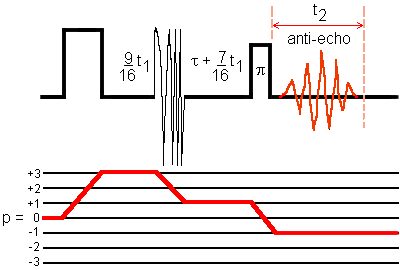Double Frequency Sweep MQ-MAS
Kentgens and coworkers investigate DFS which relies
on adiabatic passages to convert MQ to SQ coherences.
The conversion is induced by the adiabatic passage of the quadrupole
frequency through time-dependent amplitude modulated pulse:
omegaRF(t) = omegaRF*cos[omegaS -
(omegaS - omegaF)*t/(2*tau)]*t ,
which leads to two sidebands that are swept from the start frequency
omegaS to the final frequency omegaF during the sweep duration tau.
Converging and diverging sweeps have different effects on the echo and the anti-echo process.

This figure represents phase modulated 3QMAS experiment applied to a spin I = 3/2 with split-t1 approach, whose conversion pulse is replaced with DFS.
First the excitation and conversion pulse duration and the selective pi pulse duration are optimized in the normal sequence using RF pulses.
Then the conversion pulse is replaced by a DFS. Sweeps of different duration are optimized as a function of the RF field strength omegaRF.
ACQUISITION: F1-QF
Split-t1 approach avoids shearing transformation.
